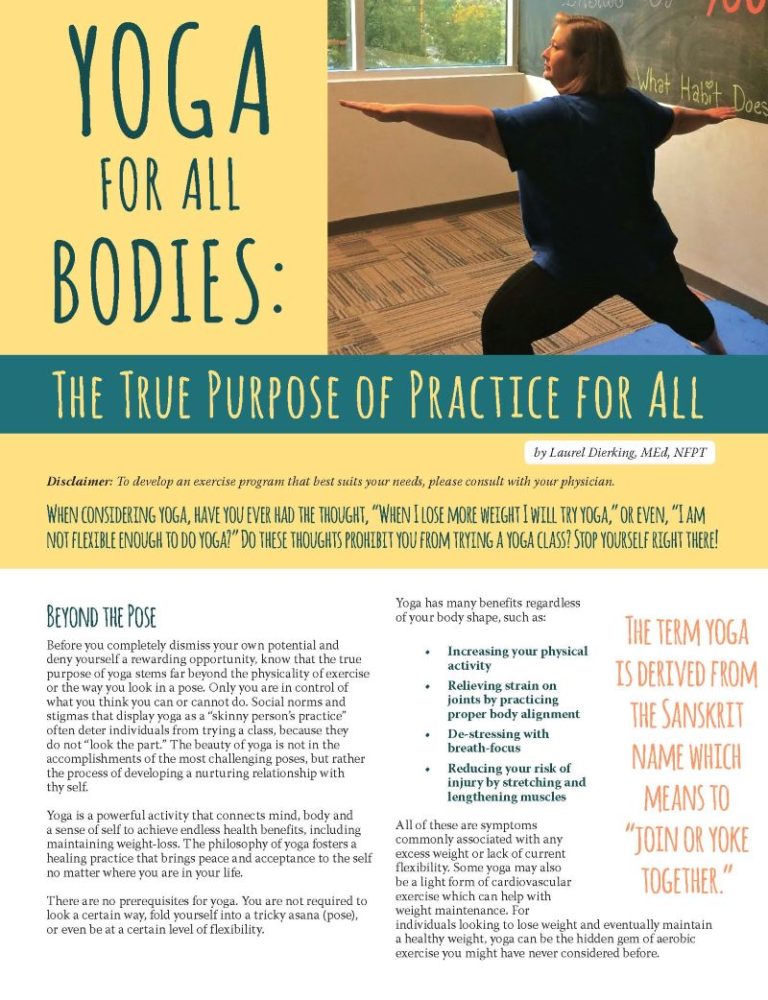YOGA FOR ALL BODIES: The True Purpose of Practice for All


by Laurel Dierking, MEd, NFPT
Winter 2015
Disclaimer: To develop an exercise program that best suits your needs, please consult with your physician.
When considering yoga, have you ever had the thought, “When I lose more weight I will try yoga,” or even, “I am not flexible enough to do yoga?” Do these thoughts prohibit you from trying a yoga class? Stop yourself right there!
Beyond the Pose
Before you completely dismiss your own potential and deny yourself a rewarding opportunity, know that the true purpose of yoga stems far beyond the physicality of exercise or the way you look in a pose. Only you are in control of what you think you can or cannot do. Social norms and stigmas that display yoga as a “skinny person’s practice” often deter individuals from trying a class, because they do not “look the part.” The beauty of yoga is not in the accomplishments of the most challenging poses, but rather the process of developing a nurturing relationship with thy self.
Yoga is a powerful activity that connects mind, body and a sense of self to achieve endless health benefits, including maintaining weight-loss. The philosophy of yoga fosters a healing practice that brings peace and acceptance to the self no matter where you are in your life.
There are no prerequisites for yoga. You are not required to look a certain way, fold yourself into a tricky asana (pose), or even be at a certain level of flexibility.
Yoga has many benefits regardless of your body shape, such as:
- Increasing your physical activity
- Relieving strain on joints by practicing proper body alignment
- De-stressing with breath-focus
- Reducing your risk of injury by stretching and lengthening muscles
All of these are symptoms commonly associated with any excess weight or lack of current flexibility. Some yoga may also be a light form of cardiovascular exercise which can help with weight maintenance. For individuals looking to lose weight and eventually maintain a healthy weight, yoga can be the hidden gem of aerobic exercise you might have never considered before.
Yoga – Defined
The term yoga is derived from the Sanskrit name which means to “join or yoke together.” As we develop our own yoga practice, become more aware of ourselves, and learn to feel compassion for our bodies, we are better able to share that same compassion to those around us, thereby uniting the human species in an uplifting way.
Yoga is a well-rounded, holistic approach to physical activity with endless physical, mental, psychological, and emotional benefits.
Benefits of Yoga
- Yoga is a great asset for those who may be affected by excess weight or obesity. Using proper alignment, your own body weight, and body awareness, you will learn to engage your muscles to support your body rather than using your bones and joints, which is damaging throughout time. Doing so builds muscle tissue surrounding your joints, which eases tension and strain from excess weight.
- Stretching and lengthening muscles is imperative to maintaining healthy joints and reducing your risk of injury. This form of strengthening creates heat in the body, which can detoxify pores and internal organs. Increasing your core temperature purges your body of toxins and chemicals that feed inflammation and disease.
- Partnering physical activity with adequate rest and a clean healthy diet are crucial elements of successful weight-loss management, all of which are encouraged by a regular yoga practice and backed by yoga philosophy. Weight-loss success is fostered through yoga along with endless benefits to those who are affected by obesity.
Yoga for Weight-loss
Amongst the endless benefits of yoga, there are a few that are particularly helpful to individuals who are affected by excess weight or obesity, beyond the physical plane. Flexibility, cardiovascular fitness, strength and mental health are invaluable aspects of a regular yoga practice that may foster weight-loss. However, there are more advantages to be had. Benefits of yoga include:
- Emotional stability
- Stress relief
- Defined muscle tone
- Weight-loss
- Relieves depression
- Enhanced self-confidence and self-worth
- More restful sleep
- Heightened immune system
- Refined brain function
- Improved memory retention
- Preserves DNA
- Reduces inflammation
- Supports joints, bones and spinal structure
- Improved cardiovascular health
- Blood pressure control
- Sustainable energy
- Better balance
No matter what your goals, success and progress in exercise is greatly affected by three factors: frequency, intensity, and duration. If your goals are weight-loss, frequent low intensity and long duration of exercise is key to weight-loss. A consistent, ongoing yoga practice can reshape your body through low impact aerobic exercise. When deciding which type of yoga to begin with, choose a gentle beginner level class like Hatha yoga or a restorative class to ease your way into your new practice.
Where to Start
The very first place to start is within you. WE ARE OUR OWN ANSWER. You must mentally open yourself up to new experiences. Begin to prepare your body by stretching daily. This is beneficial to reducing soreness, relieving strain on your joints, lengthening muscles, and relaxing your body. Use this time spent stretching to connect with your breath.
In yoga, you will learn breath-focus as THE most important aspect. Observe your breath and practice “stillness” within your mind. Our minds have been conditioned to think constantly without rest. Meditation and breath awareness takes practice. Release your thoughts as frequently as they arise, and allow yourself to refocus your attention on your breath. Be patient with yourself. This too is part of the beautiful journey to peace.
TIPS FOR STARTING YOGA
- For your first class, seek a yoga studio (as opposed to big-name gyms that teach yoga classes) with instructors who have completed at minimum an accredited 200-hour yoga teacher training curriculum. Most yoga studios offer your first class for free, so take advantage! Not all yoga is alike and class types and settings vary. Therefore, if you do not care for the first class, do not assume all yoga is the same, and try another class (this is the practice of keeping an open mind).
- Many yoga studios now offer yoga classes specifically for people who are affected by excess weight or obesity. This may be a more comfortable place to start since the class and asanas are structured specifically to accommodate the most common ailments that are experienced by individuals who are affected by obesity. Hatha yoga and restorative forms of yoga, such as Yin yoga, are functional soothing forms of yoga that have been studied and proven to aid in weight-loss.
- Taking the first step of walking in the door may be the most frightening part of a yoga class, but remember, this is a completely individualized practice. Everyone in the class will potentially be performing at different levels. It is common and expected for first-timers to be looking around to see what everyone else is doing when the instructor calls out a pose. Do not feel embarrassed for not knowing “Utkatasana” (chair pose) when heard for the first time. Prior to class, a mindful instructor will demonstrate a universal resting asana that you can bring yourself into at any time during your practice, either to rest or reconnect with your breath. “Balasana,” or child’s pose, is a restorative resting posture that you can relax into anytime you feel tired or need a break from the asanas. Like anything else, the more you practice, the more familiar with the poses and names you will become. Yoga is not competition and it is not your duty to keep up with the fittest person in the class. Let go of your ego, keep your focus on yourself, and see where you are in your own practice without the burdensome comparison to others.
- More importantly, have compassion for your body throughout your practice and let your body guide you into how far you can go into a pose. Learning yourself in this way will serve you greater than forcing yourself into a challenging pose. Breathe easy; make it simple; look around and learn through observation. Before you know it, you will be able to keep your eyes focused and move into the poses on your own. Honor your body wherever you are in your practice. Open yourself to growth and recognize that every bit of matter that surrounds you is offering the opportunity to succeed.
Conclusion
The benefits of practice are endless. As a light form of aerobic exercise, yoga can help to alleviate common symptoms of being affected by obesity, such as:
- stress
- depression
- emotional instability
- achy joints
- lack of flexibility
- weak muscles
- poor posture
- damaged immune systems
- lack of energy
- low self-esteem
- instability
Yoga is not defined by how deep you come into a pose, but rather the relationship that is developed with the breath and your body.
Yoga offers a learning environment free of judgment and expectations, with you as your most influential teacher. Although there are some individuals that make even the trickiest asana seem simple, all levels of expertise are significant and even the most well-known yogis worked up to where they are. As in life and nature, everything and everyone is important in their existing role. Step onto a mat and honor yourself and your space in the present moment.
Open your heart to a beautiful practice and learn to love yourself. Give yourself the opportunity to surprise you. Social conditioning and norms, the ego, and self-doubt are discouraging mind frames that yoga can help to diminish. Break free of what stops you and see for yourself that you can only benefit. The practice of yoga teaches us to let go of what we think we know, expand our hearts and open our minds to endless possibilities and all the success you could ever imagine for yourself. Acceptance of yourself for where you are in this moment allows you to move forward with your weight-loss goals. Compassion for the self generates compassion for all. Your life and the world would be a better place for it. Flexibility, strength, ethnicity, shape, age, weight, height, and limitations make no matter in yoga. Yoga is for all bodies.
About the Author:
Working within the health field for three years, Laurel Dierking MEd, NFPT, is passionate about cultivating body, mind and spirit awareness through holistic health practices. As a Health and Fitness Professional and yoga instructor at JKFITNESS, Laurel strives to guide individuals on a path to self-awareness, long-term functional fitness, and weight-loss management.
by Yelena Kibasova Spring 2024 The fitness world is evolving, with new trends and innovations that promise…
Read Articleby Robyn Pashby, PhD Winter 2024 “No one is ever going to date you if you don’t…
Read Articleby Zack Lucks, NASM-CPT, EMT Winter 2024 Working out with a loved one is a great way…
Read Article








